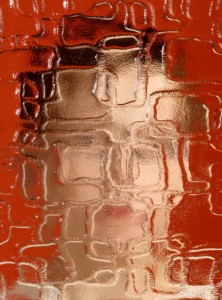The Whole-Half Self (Part 1)
By Asher Crispe: February 5, 2013: Category Inspirations, Thought Figures
Readings of R.D. Laing’s Existential Psychology
In the opening of The Divided Self: An Existential Study in Sanity and Madness, R.D. Laing establishes the following definition of schizophrenia:
The term schizoid refers to an individual the totality of whose experience is split in two main ways: in the first place, there is a rent in his relation with his world and, in the second, there is a disruption of his relation with himself. Such a person is not able to experience himself ‘together with’ others or ‘at home in’ the world, but, on the contrary, he experiences himself in despairing aloneness and isolation; moreover, he does not experience himself a complete person but rather as ‘split’ in various ways, perhaps as a mind more tenuously linked to a body, as two or more selves, and so on. (p.17)
 Presented as such, the schizoid condition forms one of the key elements of exile within the context of the Hebraic tradition. When ‘Egypt’ becomes one’s entire world, when we perceive ourselves as completely alien in our environment, when we are in foreign lands, then it is difficult, if not impossible, to feel (as Laing puts it) ‘together with’ others or ‘at home in’ such a place. The archetype of all exiles (Egypt) provides us with an excellent model for psychic displacement. Whether it be an entire people or an individual, the sense of ‘aloneness’ and ‘isolation’ under such hostile conditions buries our individuality in the sand or fashions our being into the inanimate bricks used to build the structures of our task masters. Violated by powers beyond our control, we then realize that life is elsewhere. Home is certainly not here. Such an exile makes us all schizoid.
Presented as such, the schizoid condition forms one of the key elements of exile within the context of the Hebraic tradition. When ‘Egypt’ becomes one’s entire world, when we perceive ourselves as completely alien in our environment, when we are in foreign lands, then it is difficult, if not impossible, to feel (as Laing puts it) ‘together with’ others or ‘at home in’ such a place. The archetype of all exiles (Egypt) provides us with an excellent model for psychic displacement. Whether it be an entire people or an individual, the sense of ‘aloneness’ and ‘isolation’ under such hostile conditions buries our individuality in the sand or fashions our being into the inanimate bricks used to build the structures of our task masters. Violated by powers beyond our control, we then realize that life is elsewhere. Home is certainly not here. Such an exile makes us all schizoid.
When we speak of the dangers of assimilation within exile, we are paralleling the psyche of the schizophrenic for whom, according to Laing (p. 71) “The whole organization of his being rested on the disjunction of his inner ‘self’ and his outer ‘personality’. Outwardly, the people appeared as slaves in Egypt at the time of the Exodus. Today too, our exteriority is plastered over with sticky paper which may falsely advertise us, while concealing the real person underneath who may seldom or never get to show himself or herself in public. Our plight in the modern day world is just as much an inner and outer tension and estrangement or as Laing describes it (p.72): “The outward appearance could not reveal the fact that his ‘personality’ was no true self-expression but was largely a series of impersonations.” When we operate in roles that are not of our own choosing or which we are ill-fitted for, we begin to suffer as actors who no longer recognize themselves.
In order to tackle this psychological syndrome, we will summon one of the foundational teachings of the 13th century kabbalist Rabbi Avraham Abulafia who states that everything in reality has aspects of wholeness and halfness (shalem v’chetzi) to it. In the later strata of mystical writings by the Chassidic masters these terms are replaced with the words limitless (infinite [bli gevul]) and limited (finite [gevul]). Limitlessness-wholeness remains undivided while the nature of limitedness and incompleteness does cut into things. When we consider the psychological ramifications of these terms we can detect both aspects within a person.
On some level, my inner being remains perfectly intact and undefined. It is untouched by my exile into this restrictive world. The core of who I am cannot truly be bound nor limited and all attempts to do so would result in an incomplete representation that would create schisms within my consciousness of myself. Nonetheless, I feel compelled to find a means of self-expression, to be communicative even if it is partial and incomplete. I’ll sometimes settle for poor representation. The way in which I am purely present–the simplicity of my entire being which cannot be broken up–co-exists with a projected fragmentation that splits my ‘self’ into inner and outer dimensions.
This situation is incisively articulated in the esoteric understanding of God instructing Moshe/Moses how to perform a census of the people in Shemot/Exodus (30:11-16) whereby everyone contributes exactly one half shekel coin which is counted in place of directly counting the people. While there are many layers to this ‘performative’ (mitzvah), some commentators explain that by contributing a half shekel coin, the people were able to bring rectification for the sin of the golden calf. What then is the connection between an paradigmatic act of idolatry and the donation of a half shekel coin? How is this reflected psychologically within the self?
Our first clue comes from a passage in the Zohar (II 187b) which calls our attention to the precise wording of the last four words of Shemot/Exodus 30:13 which state “half a shekel of the [literally ‘in the’] sacred shekel.” This half shekel coin is based on the shekel of the Holy Sanctuary. Another more expansive rewording of this translation would be to say that ‘half a shekel’ can only be measured or defined within the context of a ‘whole shekel’ which is itself sacred–that is an undivided wholeness that is always held in reserve and inviolable. Incompleteness is juxtaposed with completeness.
 There are many reasons why this coin is called a shekel. For now, we will merely point out that its three Hebrew letters Shin-Kuf-Lamed (300+100+30) equal 430 which is the same numerical value as the word nefesh or ‘soul’ (Nun-Pei-Shin or 50+80+300). What this comes to tell us is that the coinage provides a ‘conversion value’ for the soul. This currency works on a ‘psychic exchange.’ If I contribute only a half shekel it therefore means that I am fundamentally incomplete and that I require a relationship with an other to be made whole. My essential halfness (which is separate) carries with it a need for relatedness to the other in order to achieve a sense of wholeness. This would be comparable with the following characterization of these issues from Laing:
There are many reasons why this coin is called a shekel. For now, we will merely point out that its three Hebrew letters Shin-Kuf-Lamed (300+100+30) equal 430 which is the same numerical value as the word nefesh or ‘soul’ (Nun-Pei-Shin or 50+80+300). What this comes to tell us is that the coinage provides a ‘conversion value’ for the soul. This currency works on a ‘psychic exchange.’ If I contribute only a half shekel it therefore means that I am fundamentally incomplete and that I require a relationship with an other to be made whole. My essential halfness (which is separate) carries with it a need for relatedness to the other in order to achieve a sense of wholeness. This would be comparable with the following characterization of these issues from Laing:
This is that each and every man is at the same time separate from his fellows and related to them. Such separateness and relatedness are mutually necessary postulates. Personal relatedness can exist only between beings who are separate but who are not isolates. We are not isolates and we are not parts of the same physical body. Here we have the paradox, the potentially tragic paradox, that our relatedness to others is an essential aspect of our being, as is our separateness, but any particular person is not a necessary part of our being. (p.26)
In light of the Zohar’s selection of words, we see that the ‘divided self’–my experience of halfness or incompletion–stands out against the background of a higher sense of wholeness and completeness by which everything is weighed. The incomplete self is compared with a complete self. However, following Laing’s logic, the complete self is not permitted to retain total separateness but rather places me in relationship with others.
In Part Two, we will attempt to discover how all our wholeness and halfness applies to the inexpressible and expressible levels of our experience.
http://www.interinclusion.org/inspirations/the-whole-half-self-part-2/
The Whole-Half Self (Part 1),























;)
;)
;)
;)
;)
;)
;)
;)
;)
;)

Well alrighty then. I dont think i would have understood this as well if anyone else wrote but you. Thats that ina nutshell and a half. 🙂
Rabbinic language is precise while losing nothing of the poetic, and you’ve done a good job of showing how what seemed to be esoteric was prescient of modern psychology.